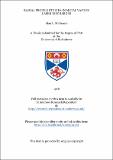Files in this item
Radial profile studies in metal vapour laser discharges
Item metadata
| dc.contributor.advisor | Dunn, Malcolm H. | |
| dc.contributor.advisor | Maitland, Arthur | |
| dc.contributor.author | McKenzie, Alan L. | |
| dc.coverage.spatial | 179 p. | en_US |
| dc.date.accessioned | 2018-06-20T10:32:23Z | |
| dc.date.available | 2018-06-20T10:32:23Z | |
| dc.date.issued | 1976 | |
| dc.identifier.uri | https://hdl.handle.net/10023/14313 | |
| dc.description.abstract | Positive-column metal-vapour lasers are important because of the many visible and ultra-violet c.w. wavelengths attainable. In many such systems population inversion among the metal ion states is produced in charge-exchange reactions with helium ions. Although the power of such lasers should apparently increase linearly with the helium ion density and, hence, with the discharge current, several observers have noted a power saturation. This work describes a phenomenon which will account for this. The spontaneous emission from laser states in a helium-selenium discharge is observed across the tube, and the radial profiles of intensity show a central dip which deepens with discharge current and helium pressure. This axial depletion of laser states sets a limit to the achievable power. The dip effect is shown to be due to the removal of metal atoms from the centre of the tube by ionisation followed by a build-up of the vapour at the walls where the; metal is neutralised. States excited from the axially reduced neutral population will reflect the depletion, to some extent in their own distribution. The helium-cadmium discharge is selected as representative of metal-vapour systems for further study using the dip effect. By comparing the radial profiles of different excited states under the same discharge conditions, it is shown that electron collisions probably contribute to the excitation of levels which are normally assumed to result from charge-exchange and Penning collisions. Radial profiles of helium and cadmium metastables are examined. The behaviour of the helium profiles at high cadmium partial pressures is consistent with an electron temperature which depends upon the local cadmium concentration. The shape of the cadmium metastable profile indicates that this species is being destroyed in the discharge - either by electron collision or collisional mixing with the cadmium neutral resonance state. Observations of cadmium ion profiles at various cadmium partial pressures indicate that electron collisions are the principal source of cadmium ionisation. From the magnitude of the radial dip, the ionisation rate constant is calculated (1 - 5 x 10<super>-8</super> cm3 s-1). This varies with E/N, the reduced axial electric field. The ionisation rate is found another way, by modulating the discharge current and observing the phase lag of the profile dip. This experiment yields a value similar to the above. | en_US |
| dc.language.iso | en | en_US |
| dc.publisher | University of St Andrews | |
| dc.subject.lcc | TK7872.L3M5 | |
| dc.subject.lcsh | Lasers | |
| dc.title | Radial profile studies in metal vapour laser discharges | en_US |
| dc.type | Thesis | en_US |
| dc.contributor.sponsor | Carnegie Trust for the Universities of Scotland | en_US |
| dc.type.qualificationlevel | Doctoral | en_US |
| dc.type.qualificationname | PhD Doctor of Philosophy | en_US |
| dc.publisher.institution | The University of St Andrews | en_US |
This item appears in the following Collection(s)
Items in the St Andrews Research Repository are protected by copyright, with all rights reserved, unless otherwise indicated.

